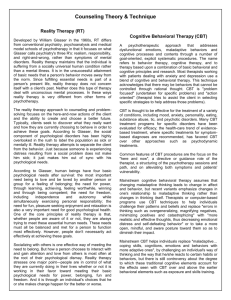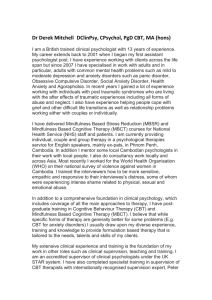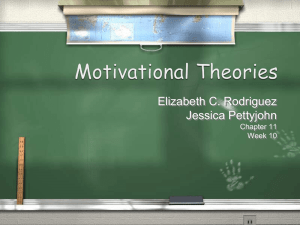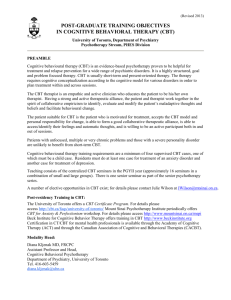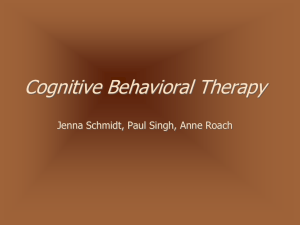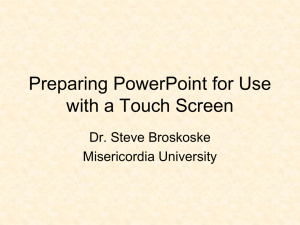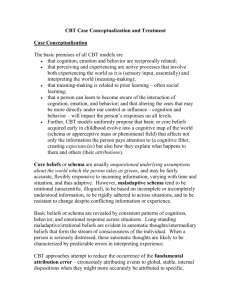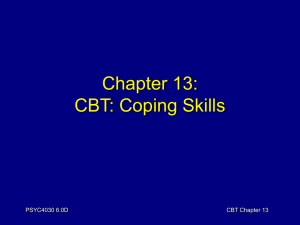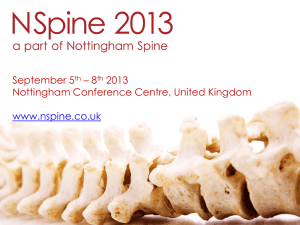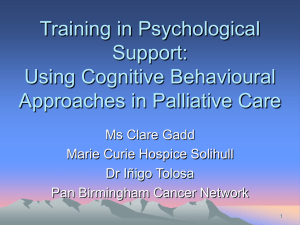Addressing Juvenile Substance Abuse and Behavior - MI-PTE
advertisement
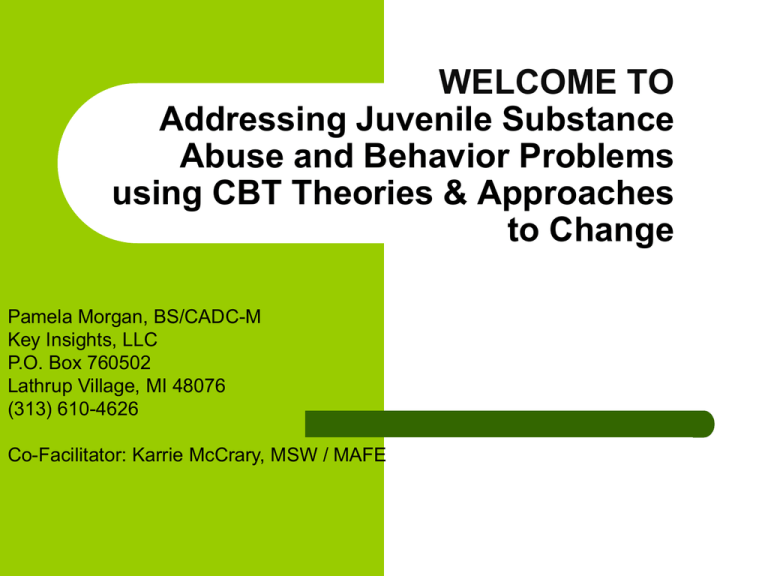
WELCOME TO Addressing Juvenile Substance Abuse and Behavior Problems using CBT Theories & Approaches to Change Pamela Morgan, BS/CADC-M Key Insights, LLC P.O. Box 760502 Lathrup Village, MI 48076 (313) 610-4626 Co-Facilitator: Karrie McCrary, MSW / MAFE MODULE I 2 Training Objective Introduction- What is Cognitive Behavior Therapy Objectives of CBT Characteristics of CBT Training Objective: 3 To enhance the Participant’s ability to utilize Cognitive Behavior Therapy to assist substance abusing juveniles and juveniles with behavior problems in making life altering changes, thereby reducing the recidivism rate. Participants will be provided with user friendly assignments to address the juvenile’s belief system, identify the current stage of change and interventions needed to motivate the adolescent to the next stage. INTRODUCTION-What is Cognitive Behavior Therapy (CBT)? 4 CBT Is an Umbrella. CBT is a very general term for a classification or families of psychotherapies with similarities. CBT is a combination of cognitive therapy and behavior therapy. It works with the thoughts of youth (what are they thinking about just before they start to use drugs, while they are using and after they finish using) and how those thoughts influence their behaviors. Problems addressed by CBT Criminal Behavior, Extreme Anger, Various Addictions – (Sexual, Drug Addiction, Overeating, Cigarette Smoking & other addictions) – Violent Behavior OBJECTIVE OF CBT 5 To identify & Monitor thoughts, assumptions, beliefs and behaviors related to debilitating, negative actions and dysfunctional displays of emotions To replace irrational thoughts with more realistic and useful ones To assist in Group, Family, and Individual Therapy Characteristics: CBT is… 6 …based on Cognitive Model of Emotional Response. …briefer and time-limited. …does not focus on the therapeutic relationship …a collaborative effort between therapist and the client. …does not tell people how to feel …uses Questions … is structured and direct … is based on an educational model-teaching to unlearn-learned behaviors …relies on homework as a central feature …deals with thinking based on fact Module II Rational Emotive TherapyAlbert Ellis/ – 1955 – – – – 7 Focuses on Beliefs and Perspective Confronts irrational core beliefs (handout) Replaces irrational core beliefs with rational ones Suggests that Emotions and Behaviors result from the cognitive process/thinking process Foundational Work Preparing the Client for Therapy Work on building trust disclosure education 8 Explain to client the basics of REBT to elicit confidence in the possibility for change 1. 2. 3. THERAPY BEGINS Identify the Problem – GAINS Assessment (client Hx) Assess clients feelings about the problem Identify causal factors (from Hx ) 9 Factors attributing to clients beliefs about self, others and the world Reflect on past long enough to establish causal effect (how the past has effected client’s beliefs) Causation Approach (ABC Theory-Albert Ellis) STIMULUS ITSELF DOES NOT ELICITS AN EMOTIONAL RESPONSE DIRECTLY CLIENT’S EVALUATION OF OR THOUGHT ABOUT THAT STIMULUS ELICITS THEIR RESPONSE. THE COGNITIVE THERAPIST ASSUMS: – – 10 1) THE CLIENT IS CAPABLE OF BECOMING AWARE OF THEIR OWN THOUGHTS AND OF CHANGING THEM 2) CLIENT’S PERCEPTION OF REALITY MAY BE DISTORTED BY STIMULI. REBT deals with CORE BELIEFS 11 (see worksheet pg. 1,2,3) The long-standing views that we hold about ourselves, others, the world and the future. Usually formed during childhood or other important times in our lives We filter our experiences through core beliefs Core Beliefs form PET PEEVES A-B-C Method (developed by Albert Ellis) (see worksheet pg. 4) 12 Activating event Belief system Consequential Response to Activating event Disputing (irrational core beliefs) Effects of Alternative Thinking Module III Stages of Change (DiClemente/ Prochaska’s Model of Change) 1. 2. 3. 4. 5. 6. 13 Pre-Contemplation Contemplation Preparation Action Maintenance Relapse SELF-EFFICACY 1. 2. 3. 4. 14 Prerequisites to Change Goals must be realistic to the client Client’s evaluation of current behaviors and current conditions must indicate new behavior is needed if new conditions are to be expected. Client must believe there are optional behaviors available and attainable Therapist must determine readiness to change and counsel at that stage Pre-contemplation Stage Defining – Individuals are either unconvinced that they have a problem or are unwilling to consider changes Approach to Facilitate Change – – Weigh Good/Bad Ask questions – 15 Raise Awareness Use Assessments Highlight inconsistencies Contemplation Stage-ambivalence Defining – – – – 16 Individual is considering the possibility of change Evaluating options having mixed feelings Doubts self, fears failing Approach to Facilitate Change – – – Explore benefits of change Scenarios / Role Play Projection – life without the behavior Preparation Stage Defining – – – 17 Individuals make a commitment as well as initial plans to change behavior No longer justifying behavior Becomes agreeable vs. arguementative Approach to Facilitate Change – – – Structure plan of action Identify & Reduce barriers/ assess environmental risks/self-defeating behaviors Identify people who will assist SELF - EFFICACY Defining – 18 One’s judgment or belief about one’s ability to deal with challenging high risk situations competently based on development and commitment to coping skills About Self-Efficacy – – – – Facilitates courage to move forward Without Self-Efficacy, change rarely occurs It is not Self-Will Must be contingent on a foundation of coping skills Case Study 19 Break into groups-Designate spokes person to report clinical insight Review Case Study/ Add variables to the client’s life. Using the CBT Technique discussed in today’s training, develop a treatment plan to assist the client in meeting the identified goal(s). Report clinical insight


